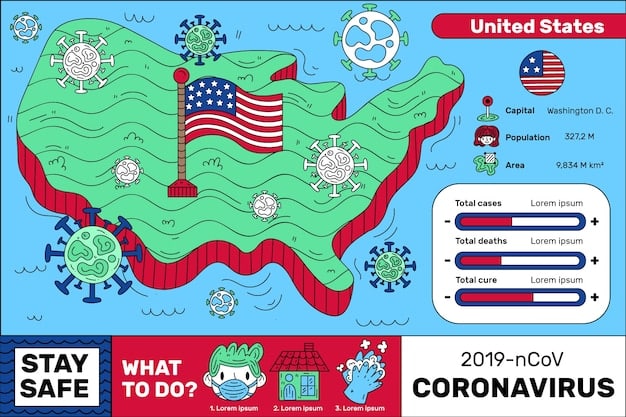CDC Flu Guidelines 2024-2025: Your Winter Prevention Guide

The updated CDC guidelines for flu prevention for the upcoming winter season emphasize vaccination, robust hygiene practices, and timely medical consultation as critical strategies to mitigate influenza transmission and severe outcomes.
As the colder months approach, understanding The Updated CDC Guidelines for Flu Prevention You Need to Know This Winter becomes paramount for safeguarding public health. These guidelines, meticulously crafted by the Centers for Disease Control and Prevention (CDC), represent the authoritative voice on influenza control, offering crucial insights for individuals and healthcare providers alike.
Understanding the Threat: Why Flu Prevention Matters More Than Ever
The flu, or influenza, is far more than just a bad cold. It’s a respiratory illness caused by influenza viruses that infect the nose, throat, and sometimes the lungs. Each year, seasonal flu can lead to millions of illnesses, hundreds of thousands of hospitalizations, and tens of thousands of deaths in the United States alone. The unpredictable nature of flu strains, coupled with its potential to cause severe complications, particularly in vulnerable populations, underscores the critical importance of effective prevention.
The Annual Cycle of Influenza
Influenza viruses are constantly evolving, leading to new strains emerging each year. This genetic drift and shift mean that immunity acquired from previous infections or vaccinations may not be entirely effective against new variants. This continuous evolution necessitates annual updates to flu vaccines and prevention strategies. Each flu season presents a unique challenge, demanding vigilance and adaptation from public health agencies and individuals.
Vulnerable Populations and Complications
While anyone can get the flu, certain groups are at higher risk of developing serious complications. These include young children, adults aged 65 and older, pregnant women, and individuals with chronic health conditions such as asthma, diabetes, and heart disease. For these groups, the flu can lead to pneumonia, bronchitis, sinus infections, and even exacerbation of existing chronic conditions, potentially requiring hospitalization or even resulting in death.
- Infants and young children are particularly susceptible to severe flu outcomes due to their developing immune systems.
- Older adults often have weakened immune responses, making them more vulnerable to flu complications.
- Pregnant women face increased risks due to physiological changes during pregnancy that can affect their immune, heart, and lung function.
- Individuals with underlying health conditions may experience a worsening of their conditions if they contract the flu.
Beyond individual health, widespread flu outbreaks can strain healthcare systems, leading to increased emergency room visits, hospital admissions, and a significant burden on medical resources. This is particularly concerning during times when healthcare systems might already be under pressure, such as during co-circulation with other respiratory viruses. The economic impact of flu is also substantial, encompassing lost productivity due to illness and healthcare expenditures. The updated CDC guidelines aim to mitigate these impacts by promoting proactive and comprehensive prevention strategies. Their emphasis on early intervention and widespread protection is designed not only to protect individuals but also to bolster community resilience against seasonal respiratory threats.
The Cornerstone of Defense: Updated Vaccination Recommendations
Vaccination remains the single most effective tool in preventing influenza and its severe complications. The CDC updates its recommendations annually, taking into account emerging strains and the latest scientific evidence to ensure the vaccine offers the best possible protection. The updated guidelines for the upcoming winter season reiterate and reinforce the importance of widespread vaccination, emphasizing accessibility and timely administration.
Who Should Get Vaccinated and When?
The CDC recommends that everyone six months of age and older should get an annual flu shot, with rare exceptions. This universal recommendation is based on the understanding that broader vaccination coverage provides greater community protection, often referred to as “herd immunity.” It’s particularly crucial for individuals at high risk of flu-related complications to get vaccinated.
Types of Flu Vaccines Available
Several types of flu vaccines are available, and the CDC provides guidance on their appropriate use based on age and health status. These typically include:
- Standard Dose Inactivated Flu Shot: Administered as an injection, suitable for most people aged six months and older.
- High-Dose Flu Shot: Specifically designed for adults aged 65 and older, containing more antigen to evoke a stronger immune response.
- Adjuvanted Flu Shot: Also for adults aged 65 and older, containing an adjuvant to create a stronger immune response.
- Recombinant Flu Vaccine: Made without the use of flu virus or chicken eggs, suitable for individuals aged 18 and older.
The choice of vaccine type might depend on supply, patient age, and any specific health considerations, with healthcare providers offering tailored advice. The goal is to provide the most effective protection available for each individual.
Timing of Vaccination
The CDC generally recommends getting vaccinated by the end of October each year, if possible. This timing allows for immunity to develop before flu activity typically begins to increase. However, vaccination throughout the flu season, even into January or later, can still provide protective benefits, especially as flu activity often peaks later in the winter. Early vaccination is preferred, but late vaccination is still better than no vaccination at all. The updated recommendations continue to stress the message that it’s never too late in the season to consider getting your flu shot, especially as flu season can be unpredictable and extend well into spring. This proactive approach ensures that populations are adequately protected before the peak of viral circulation.
Beyond the Shot: Essential Hygiene and Personal Practices
While vaccination is the first line of defense, the CDC emphasizes that it works best when complemented by robust hygiene and personal practices. These measures are crucial for reducing the spread of respiratory droplets containing the flu virus, thereby protecting individuals and the wider community. Integrating these daily habits into our routines can significantly curb the transmission rates of influenza.
Hand Hygiene: A Simple Yet Powerful Tool
Proper hand hygiene is fundamental in preventing the spread of germs, including flu viruses. The CDC consistently highlights the importance of frequent and thorough handwashing, especially after coughing, sneezing, blowing your nose, before eating, and after using the restroom.
- Wash hands often with soap and water for at least 20 seconds.
- If soap and water are not available, use an alcohol-based hand sanitizer that contains at least 60% alcohol.
- Encourage children to practice good hand hygiene, making it a regular habit.
This simple act physically removes or inactivates viruses and bacteria, preventing them from entering the body or being transferred to surfaces. The updated guidelines underscore that conscientious handwashing is a shared responsibility, critical for community health.
Respiratory Etiquette: Covering Coughs and Sneezes
Flu viruses spread primarily through droplets made when people with flu cough, sneeze, or talk. Practicing good respiratory etiquette is vital to contain these droplets and reduce transmission. This means being mindful of how you cover your mouth and nose when you cough or sneeze.

The CDC recommends covering your mouth and nose with a tissue when you cough or sneeze, then immediately disposing of the used tissue in the trash. If a tissue is not available, cough or sneeze into your upper sleeve or elbow, not your hands. This prevents contaminated hands from touching surfaces or other people.
Avoiding Touching Your Face
Our hands frequently come into contact with various surfaces throughout the day, which may harbor flu viruses. Touching our eyes, nose, and mouth with unwashed hands can transfer the virus from our hands directly into our respiratory system, leading to infection. Developing an awareness of this habit and consciously reducing face-touching can be an effective barrier against infection. These combined practices create a comprehensive barrier against viral transmission. By adopting these simple, yet powerful, habits, individuals empower themselves and contribute significantly to collective health, reducing the seasonal burden of influenza.
When to Seek Medical Attention: Recognizing Flu Symptoms and Red Flags
Knowing when to seek medical attention is a critical component of the CDC’s flu prevention guidelines. While most people with the flu will experience mild to moderate illness and recover at home, certain symptoms or risk factors warrant immediate medical consultation. Early recognition and timely intervention can significantly reduce the risk of severe complications, hospitalization, or even death, especially for high-risk individuals. Understanding your body and recognizing warning signs are key.
Common Flu Symptoms
Flu symptoms often appear suddenly and can include:
- Fever or feeling feverish/chills (though not everyone with flu will have a fever)
- Cough
- Sore throat
- Runny or stuffy nose
- Muscle or body aches
- Headaches
- Fatigue (tiredness)
- Some people may have vomiting and diarrhea, though this is more common in children than adults.
These symptoms can overlap with other respiratory illnesses, including the common cold or COVID-19, making it challenging to differentiate based on symptoms alone. Medical testing may be necessary for an accurate diagnosis.
Emergency Warning Signs for Adults
For adults, emergency warning signs that indicate a need for immediate medical care include:
- Difficulty breathing or shortness of breath
- Persistent pain or pressure in the chest or abdomen
- Sudden dizziness
- Confusion
- Severe or persistent vomiting
- Flu-like symptoms that improve but then return with fever and worse cough
These symptoms suggest a more severe illness or complication, such as pneumonia, and require urgent medical evaluation. The CDC emphasizes that delaying care can lead to worse outcomes.
Emergency Warning Signs for Children
Warning signs in children differ slightly and include:
- Fast breathing or troubled breathing
- Bluish lips or face
- Ribs pulling in with each breath
- Chest pain
- Severe muscle pain (child refuses to walk)
- Dehydration (no urine for 8 hours, dry mouth, no tears)
- Not interacting when awake
- Seizures
- Fever above 104°F (40°C)
- In infants, inability to eat, lack of tears when crying, or significantly fewer wet diapers than usual.
- Worsening of chronic medical conditions.
Parents and guardians should be particularly vigilant for these signs and seek immediate medical attention if they appear. The updated guidelines strongly advise individuals, especially those in high-risk groups, to contact their healthcare provider at the onset of flu-like symptoms. Antiviral medications, if prescribed early, can help shorten the duration and reduce the severity of the illness.
Antiviral Medications: A Treatment Option When Timely
While vaccination is the primary preventive measure, antiviral medications play a crucial role in treating influenza, particularly for individuals at high risk of developing serious flu complications. The updated CDC guidelines reinforce the importance of these medications as a valuable tool, emphasizing the critical need for timely administration to maximize their effectiveness. Antivirals are not a substitute for the flu vaccine, but they offer an important secondary defense.
How Antivirals Work
Antiviral drugs are prescription medicines that attack the flu virus directly by stopping it from reproducing in your body. This can make your illness milder and shorten the time you are sick. When taken early, ideally within the first 48 hours of symptom onset, antivirals can also reduce the risk of serious flu complications like pneumonia and respiratory failure. They are distinct from antibiotics, which target bacterial infections and are not effective against viruses.
Who Should Receive Antiviral Treatment?
The CDC recommends antiviral treatment for people who are very sick or at high risk of serious flu complications. This includes:
- People who are hospitalized with flu.
- People who are at higher risk for flu complications, such as:
- Young children (especially those younger than 2 years old)
- Adults 65 years and older
- Pregnant women and women up to two weeks postpartum
- People with certain chronic medical conditions (e.g., asthma, heart disease, diabetes, neurological conditions)
- People with weakened immune systems
- People younger than 19 years of age who are receiving long-term aspirin or salicylate-containing therapy.
Even generally healthy people who are not in a high-risk group may consider antiviral treatment if they have flu symptoms, especially if they are severe or if they have close contact with high-risk individuals. The decision should always be made in consultation with a healthcare provider.
Timeliness is Key
The effectiveness of antiviral medications is highly dependent on how quickly they are started after the onset of flu symptoms. Ideally, treatment should begin within 48 hours of symptoms appearing. Beyond this window, the benefits may be reduced, though antivirals can still be considered for very sick individuals or those with progressive illness, regardless of the time since symptom onset. The updated guidelines emphasize the critical role of healthcare providers in swiftly diagnosing flu and prescribing antivirals when indicated. Public awareness about the importance of early consultation regarding flu symptoms is crucial, as this directly impacts the efficacy of antiviral interventions. Getting timely medical advice means getting the most out of these treatments, aiding faster recovery and preventing severe disease.
Community and Public Health Measures
Individual actions, fueled by responsible personal choices, form the foundation of flu prevention. However, the CDC’s updated guidelines also highlight the indispensable role of broader community and public health initiatives in curbing influenza spread. These collective efforts create a protective shield that extends beyond individual behaviors, fostering resilience across populations. A multi-faceted approach involving public health campaigns, surveillance, and coordinated responses is crucial.
Surveillance and Monitoring
Effective flu prevention relies heavily on robust surveillance systems. The CDC, in collaboration with state and local health departments, continuously monitors flu activity across the United States. This includes tracking:
- The geographic spread of flu.
- The types of flu viruses circulating.
- The severity of flu illness, including hospitalizations and deaths.
- Antiviral resistance.
This data helps public health officials understand the evolving nature of the flu season, inform vaccine strain selection for the following year, and guide public health recommendations. Early warning signs from surveillance can trigger alerts and intensify prevention efforts where needed.

Public Health Campaigns and Education
Raising public awareness and promoting key prevention messages are vital. Public health campaigns disseminate information through various channels, encouraging vaccination, promoting good hygiene, and educating the public on symptom recognition and when to seek medical help. These campaigns often target specific demographics, such as parents, older adults, and healthcare workers, with tailored messages. Educational efforts empower individuals to make informed decisions and adopt preventive behaviors. This includes providing accessible, clear information about the safety and effectiveness of the flu vaccine, debunking myths, and highlighting the importance of every individual’s contribution to public health.
School and Workplace Guidelines
Schools and workplaces are significant environments for flu transmission due to close contact among individuals. The CDC provides guidelines for these settings to minimize flu spread, including:
- Encouraging sick individuals to stay home.
- Promoting vaccination among students, faculty, and employees.
- Implementing enhanced cleaning and disinfection protocols.
- Ensuring access to handwashing facilities and hand sanitizer.
These guidelines emphasize creating supportive environments that facilitate healthy behaviors and minimize the risk of occupational or educational spread. Some workplaces may also implement policies regarding flexible sick leave to ensure that employees do not feel pressured to come to work ill. The strength of flu prevention lies in the synergy between individual responsibility and robust community-level support. By working together, leveraging surveillance data, and implementing targeted public health interventions, communities can significantly reduce the impact of seasonal influenza, protecting the health and well-being of all.
| Key Area | Core Guideline |
|---|---|
| 💉 Vaccination | Annual flu shot for everyone 6 months and older. |
| 🧼 Hygiene | Frequent handwashing and proper respiratory etiquette. |
| ⚠️ Symptom Awareness | Recognize severe flu symptoms and seek prompt medical care. |
| 💊 Antivirals | Consider for high-risk individuals; ideally within 48 hours of symptom onset. |
Frequently Asked Questions
▼
Flu viruses constantly evolve, meaning new strains emerge each year. The previous year’s vaccine may not protect against the current dominant strains. Additionally, your immunity from vaccination can wane over time, making an annual shot essential to maintain optimal protection against the flu.
▼
No, the flu vaccine cannot give you the flu. Flu shots contain inactivated viruses or only a single gene from a virus, which means they cannot cause infection. You might experience mild side effects like soreness, redness, or low-grade fever, but these are signs your immune system is building protection.
▼
Beyond vaccination, key preventive measures include frequent handwashing with soap and water or using alcohol-based hand sanitizer. Also, avoid touching your face, especially your eyes, nose, and mouth. Cover coughs and sneezes with a tissue or your elbow, and stay home if you are sick to prevent spreading the virus to others.
▼
You should seek medical attention if your flu symptoms are severe, are worsening, or if you belong to a high-risk group (e.g., elderly, pregnant, or have chronic conditions). Emergency signs like difficulty breathing, persistent chest pain, sudden dizziness, confusion, or severe vomiting warrant immediate medical care. Early intervention can prevent severe complications.
▼
Yes, antiviral drugs can be effective in treating the flu, especially when started within 48 hours of symptom onset. They can shorten the duration of illness and reduce the risk of severe complications. Antivirals are typically recommended for people with severe flu, those at high risk of complications, or hospitalized patients.
Conclusion
As we prepare for the winter months, the updated CDC guidelines for flu prevention serve as an indispensable resource, empowering us with the knowledge and tools to protect ourselves and our communities. From the foundational importance of annual vaccination to the critical role of robust hygiene practices and timely medical consultation, these recommendations are designed to mitigate the impact of influenza. By embracing these comprehensive strategies, individuals contribute not only to their personal well-being but also to the broader public health, fostering a more resilient and prepared society against seasonal respiratory threats. Remaining vigilant and proactive, especially in the face of evolving viral landscapes, is key to navigating the flu season safely and effectively.





